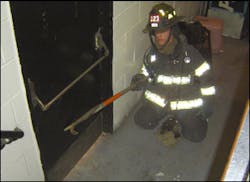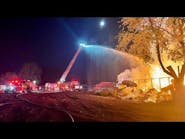The hook, or pike pole is one of the primary tools that has been used by truck company firefighters for years. This tool has under gone some transformation, but is mainly the same tool it was 30 or 40 years ago. This tool should be brought into every fire building today. Pike poles have many uses and many types are available.
Six-Foot Wooden Handle Hook
The first type of hook is a wooden handled six-foot hook. This tool is a standard style and performs the functions required to open up walls and ceilings very well. The tool will also allow you to use it for a search aid and close the door to a fire room without unduly exposing the firefighter to injury.
The problem with this tool is that the handle is wooden and tends to break under stress. Firefighters have broken these tools, and without knowing it, they have placed the tool back on the apparatus. The next firefighter removing the tool from the apparatus has a broken tool and does not know that. When the tool is most needed is when the break is going to become evident and might impact the safety of the firefighter or a person on their search team.
If you bring a wooden hook then you or your search partner must bring a striking tool with you. That would be an axe or a Halligan, most likely. If you become trapped and need a tool to help remove yourself from danger, there is a possibility that the hook will break and if you do not have another tool then you are in real trouble.
The Fiberglass Handle
The second type of hook has a fiberglass handle. These hooks are very durable and withstand the abuse placed on them during fire operations. They come in all kinds of shapes and sizes. These hooks are used every day by the American fire service and the do a great job.
The hooks should be configured to meet the department's needs on the fireground and be able to accomplish as many tasks as possible at the scene of a working fire. The hook should be able to perform more than one task on the fire scene. The more functions a tool can perform, the less that has to be carried by the firefighters and officers.
The "New York Roof Hook"
The third type of hook has a metal handle and both the head and butt ends vary greatly. The most versatile and widely used is the metal "New York Roof Hook." This tool was developed for use by the roof firefighter in New York City and was designed to be used in many functions.
The most common features a flat side and a raised side on the head. The flat side allows it to be slid along a wall to remove any molding that's obstructive. It also can be used to open up walls or ceilings.
The "New York Roof Hook" comes with a variety of butt ends. They have a gas valve shut-off, blunt ends or a chisel point end.
The gas shut-off is rarely used and most departments have a separate gas shut-off key. So why are they still being sent to fire departments? The butt end does allow the firefighter on the roof to push down the top floor ceiling with a little more ease, but how often is that done? The chisel end will allow firefighters to remove baseboards and molding with little effort and gives the tool another working end. So if they ask for your input, get a chisel end tool.
The metal hook also can be a striking tool and a substantial object in an emergency. This tool is a very versatile and should be part of the normal compliment of tools brought to the fireground.
The choices of hooks are great and vary widely with their type and design. When ordering pike poles, look at what tool will accomplish the necessary tasks and also allow you to do more then one job with. That is the one you want to purchase - the one that allows you to do more.
Learn from Captain Dugan Live: Captain Dugan will be teaching Engine and Truck Company Coordinated Fire Attack, Hands-on Training at Firehouse World in San Diego in February 2008.Michael M. Dugan is a 22-year veteran of the FDNY, serving as the Captain of Ladder Company 123, in Crown Heights Brooklyn. As a Lieutenant, Dugan served in Ladder Company 42 in the South Bronx. While assigned as a firefighter in Ladder Company 43, in Spanish Harlem, Firefighter Dugan received the James Gordon Bennett medal in 1992 and the Harry M. Archer Medal in 1993, the FDNY's highest award for bravery. He is also a former volunteer firefighter, with the Halesite Fire Department. He has been involved with the fire service for 32 years.
He was an instructor at the inception of the FDNY's Annual Education Day and has developed programs currently taught to all FDNY members during Annual Education Day. He is the lead instructor for "Engine and Truck Company Hands-on Training (HOT) programs at Firehouse Expo and Firehouse World. He is a contributing editor for Firehouse Magazine. Captain Dugan has been a featured lecturer around the country and at both the Firehouse Expo and the Firehouse World on topics dealing with truck company operations and today's fire service.
Michael has presented two webcasts on Firehouse TrainingLIVE: Firefighter Safety with Lightweight Building Construction in 2007 and Ventilation: The Problem And Effect On Today's Buildings. He has also participated in Training & Tactics Talk on Radio@Firehouse.
You can reach Michael by e-mail at: [email protected] or contact him through his website: www.NYFiretraining.com.





